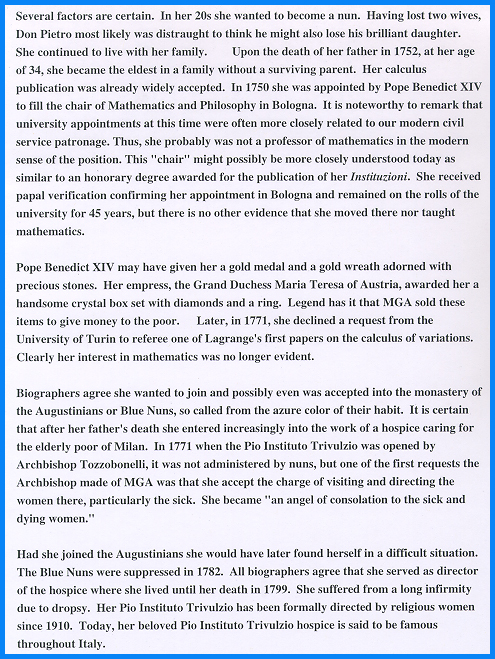


Back to . . .
 |

Back to . . . |
|
An account of MGA's attitude toward both her religious life and her mathematics is vividly recounted in a letter written by a traveling visitor in her home, M. D. Brosses, the first President of the Parliament of Dijon, and a member of the Royal Academy of Inscriptions and Belles Lettres of Paris.
A young MGA remarked that while one person might receive amusement from a formal discussion of "academic disputation," there were "twenty who were tired to death of it; and therefore such subjects were only fit to be entered upon in small companies of two or three persons, who had all the same taste, for discussing them. This observation I though very just and was a proof of the same good sense and discernment which appeared in her former learned discourses. I was very sorry to hear that she was determined to go into a Convent, and to take the veil; which was not from want of fortune, for she was rich, but from a religious and devout turn of mind, which disposes her to shun the pleasures and vanities of the world."However, let the modern reader note that in her time, many men went into religious life in order to dedicate themselves to scholarship. Many - most - professors belonged to monastic orders. For Agnesi to join a convent was not necessarily a rejection of access to a scholarly life.
 |
| During her 20s, MGA became a "perfect model and
unstinting victim of Christian Charity," despite the "severe restraint"
her father imposed on her. MGA's life style of living in remote areas
of the household and spending her days in serving "infirmed old women"
combined with her sister's refusal of an "insubstantial" proposal of marriage
led to rumors of Don Pietro's neglect of his daughters.
A. F. Frisi, Elogio storico.....(1799).
"There, [a reference to the Spanish El Teatro Critico (1774)], Agnesi is qualified as a Professor at the University of Bologna who had retired to a monastic life amongst 'The Blue Nuns', and her father is reported as having been a 'creditable tradesman in Milan.'" John Hellins in his preface to Colson's translation
(1801) of Instituzioni.
|
"We cannot behold without the greatest astonishment
a person of a sex [females] that seem so little fitted to tread the thorny
paths of these abstract sciences, penetrate so deeply as she has done into
all the branches of Algebra, both the common and the transcendental, or
infinitesimal. She has since retired to a cloister: and, though we
do not presume to censure her conduct in this step, (which we must suppose
to proceed from the purest and sincerest piety,) we cannot but lament that
she should have thus deprived the learned world of the useful improvement
in Literature which her genius and knowledge would have enabled her to
communicate to it, not only on subjects of a mathematical nature, but on
many others of a different kind, in which she had become eminent."
Jean Étienne Montucla (1725-1799) Histoire des Mathématiques, Paris, 1758. |